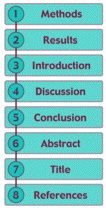SECTION FOUR : Discussion
Interpreting the results of the lab
Step 1: Write a sentence or two stating whether
or not the results from the lab procedure fully support your hypothesis,
do not support the hypothesis, or support the hypothesis but with certain
exceptions.
More Help:
Experimental science is all about testing
hypotheses. Thus, the statement of whether or not your hypothesis has
been supported is critically important to the lab report. It is by no
means a failure if your data do not support your hypothesis; in fact,
that can be more interesting than the other way around, because you
may find a new perspective for looking at the data. Failure to support
hypotheses is common in science, and often serves as a starting point
for new experiments.
- Go back to the statement of hypothesis in the Introduction. Then review
your findings, the data from the experiment. Make a judgment about whether
or not the hypothesis has been supported. It is at this point that you,
as a scientist, must be as unbiased and objective as possible.
- Write a statement stating your judgment. There are three possible
judgments you can make:
- the data support the hypothesis;
- the data do not support the hypothesis; or
- the data generally support the hypothesis but with certain exceptions
(tell what those exceptions are).
Example: "The hypothesis that X
solution would increase in viscosity when solutions Y and Z were added
was supported by the data."
Step 2: In a paragraph, identify specific
data from your lab that led you to either support or reject your hypothesis.
Refer to the visual representations of your data as evidence to back up
your judgment about the hypothesis.
More Help:
It is important to back up the statement about
the hypothesis with direct evidence from the lab data that support,
do not support, or partially support the hypothesis.
- Return to the Results to identify the particular data that led you
to your judgment about the hypothesis.
- Write a paragraph (or 2 if necessary) in which you present the relevant
pieces of data from the lab and show how they relate to the hypothesis.
- Refer to data from specific visuals appropriately: Table 1, Figure
2, etc.
Step 3: In a paragraph, use your understanding
of the scientific concept of this lab to explain why the results did or
did not support your hypothesis. If the hypothesis from the Introduction
was not fully supported, show how your understanding of the scientific
concept has changed. Note any citations you use here for including in
the Reference section of your report.
More Help:
In Step 2 you pointed to data that led you
to your judgment about your hypothesis. Now you use your understanding
of the scientific concept of the lab to explain your judgment. Whatever
the relationship between the hypothesis and the results, you must provide
a logical, scientific basis for it.
- Return to the scientific reasoning you used to generate your hypothesis
(at the end of the Introduction). Use it and your understanding of the
scientific concept of the lab as starting points for your explanation.
Your explanation is likely to follow one of four scenarios. Choose the
one that best fits your report:
- If the results fully support your hypothesis and your reasoning
in the Introduction were basically sound, then elaborate on your
reasoning by showing how the science behind the experiment provides
an explanation for the results.
- If the results fully support your hypothesis but your reasoning
in Introduction was not completely sound, then explain why the initial
reasoning was not correct and provide a better reasoning.
- If the results generally support the hypothesis but in a limited
way, then describe those limitations (if you have not already done
so) and use your reasoning as a basis for discussing why those limitations
exist.
- If the results do not support your hypothesis, then explain why
not; consider (1) problems with your understanding of the lab's
scientific concept; (2) problems with your reasoning, and/or (3)
problems with the laboratory procedure itself (if there are problems
of reliability with the lab data or if you made any changes in the
lab procedure, discuss these in detail, showing specifically how
they could have affected the results and how the uncertainties could
have been eliminated).
Step 4: Discuss other items as appropriate,
such as (1) any problems that occurred or sources
of uncertainty in your lab procedure that may account for any unexpected
results; (2) how your findings compare to the findings of other students
in the lab and an explanation for any differences; (3) suggestions for
improving the lab.
More Help:
After dealing with the critical issue of the
hypothesis, the rest of the Discussion may consider other issues. You
can address these in separate paragraphs.
- Return to the notes you took during the lab procedure. Look for possible
sources of uncertainty in setting up the lab, calibrating instruments,
and taking measurements as well as problems with materials you are using.
- In scientific articles, the Discussion is where scientists typically
compare their results to those from other scientific experiments. You
can do something similar by comparing your results to those of other
students in the lab. In your paragraph, comment on any similarities
or differences you find and offer possible explanations for the differences.
Be sure to check with the lab instructor to see if it is permissible
to compare results.
- Professors who write lab manuals are typically interested in how they
can improve the experiments in the manuals. You can also demonstrate
your ability to provide productive critique of the lab by offering suggestions
for improvement.
For advanced labs:
- It may be useful to classify the kinds of uncertainty you have identified.
Sources of uncertainty can be classified as random--those that cannot
be predicted--or as systematic--those that are related to personal uncertainty,
procedural uncertainty, or instrumental uncertainty.
|





